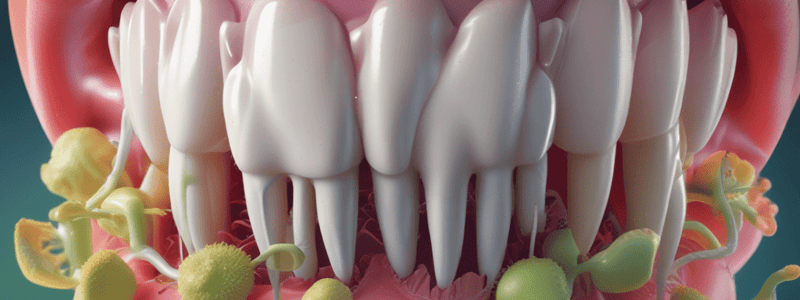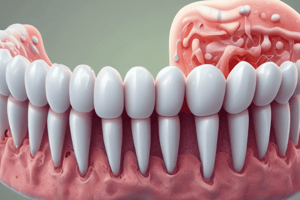Podcast
Questions and Answers
What is the role of Glucosyl transferases in Streptococcus mutans?
What is the role of Glucosyl transferases in Streptococcus mutans?
- Enabling binding to oral mucosa
- Adhering to surfaces (correct)
- Producing acid in low pH conditions
- Breaking down lactate for growth
What distinguishes Lactobacillus from other oral bacteria?
What distinguishes Lactobacillus from other oral bacteria?
- Its presence exclusively in the oral cavity
- Its ability to produce glucan polymers
- Its requirement for low pH habitats (correct)
- Its ability to initiate caries
What is the main function of Glucan binding proteins in Streptococcus mutans?
What is the main function of Glucan binding proteins in Streptococcus mutans?
- Producing acid in low pH conditions
- Breaking down fermentable carbohydrates
- Releasing enzymes for biofilm formation
- Facilitating binding of bacteria with glucan to oral mucosa (correct)
Why is it beneficial for Streptococcus mutans to be both acidogenic and aciduric?
Why is it beneficial for Streptococcus mutans to be both acidogenic and aciduric?
Which of the following is associated with carious lesions?
Which of the following is associated with carious lesions?
What is the role of alpha-amylase in plaque and caries?
What is the role of alpha-amylase in plaque and caries?
What is the purpose of extracellular polysaccharides (EPS) produced by bacteria in plaque?
What is the purpose of extracellular polysaccharides (EPS) produced by bacteria in plaque?
What is the role of enolase in glycolysis?
What is the role of enolase in glycolysis?
What effect does fluoride have on the glycolysis cycle?
What effect does fluoride have on the glycolysis cycle?
Flashcards are hidden until you start studying
Study Notes
Development of Dental Caries
- 4 factors required: teeth, bacteria in plaque, fermentable carbohydrate in diet, and time
Nutrient Sources for Bacteria
- Saliva
- Gingival crevicular fluid
- Host diet
Main Bacteria in Caries
- Streptococcus mutans
- Lactobacillus
- Veillonella
Acidogenic and Aciduric
- Acidogenic: produces high levels of acid
- Aciduric: can survive and flourish in low pH conditions
- S. mutans is both acidogenic and aciduric, allowing it to keep producing acid in low pH conditions
Virulence Factors for S. mutans
- Antigen I/II (enables adherence to surfaces)
- Glucosyl transferases (produce glucan polymers from sucrose)
- Glucan binding proteins (enable bacteria with glucan to bind to oral mucosa)
Lactobacillus
- Found in other parts of the body and in fermented foods
- Opportunistic organism that requires low pH habitat
- Colonizes existing lesions, does not initiate caries
Veillonella
- Gram-negative anaerobic cocci
- Grow using lactate as a substrate for growth
- Beneficial in caries, using lactate produced by streptococci and lactobacilli
Other Acidogenic Species
- Scardovia wiggsiae
- Propionibacterium acidfaciens
- Bifidobacteria
Plaque Hypothesis
- 3 stages: dynamic stability, acidogenic, and aciduric
- Dynamic stability: acid production, followed by alkalization phase
- Acidogenic stage: repeated sugar intake, poor oral hygiene, and reduced salivary flow
- Aciduric stage: selection of aciduric bacteria, environmental change, and shift in microbiota
Saliva's Role in Caries
- Amylase is critical in plaque and caries
- Alpha-Amylase hydrolyzes starch to glucose and maltose, making them available for fermentation
- Binds with high affinity to oral streptococci, retaining activity when bound
Sugar Sources
- Host diet
- Salivary components (sucrose, maltose, and maltooligosaccharides)
Sugar Transport and Glycolysis
- Sugars transported to interior of cells via the phosphotransferase system (PTS)
- Glycolysis results in pyruvate and 2 ATP molecules
Extracellular Polysaccharides (EPS)
- Formed from bacterial metabolism of sucrose
- Become part of the plaque matrix
- 3 roles: sticky polymers contributing to bacterial adherence, resistance to washing away, and source of sugars for metabolism when nutrients are limited
Intracellular Polysaccharides (IPS)
- Formed by S. mutans
- Storage molecules for later use
Glucosyl Transferases
- 3 produced by S. mutans: GTFB, GTFC, and GTFD
- GTFB and GTFC produce water-insoluble glucans
- GTFD produces water-soluble glucans
Glucan Synthesis and Hydrolysis
- Glucan synthesised by glucosyl transferase
- Glucan hydrolyzed by glucanase
Fructan Synthesis and Hydrolysis
- Fructan synthesised by fructosyl transferase
- Fructan hydrolyzed by fructanase
Studying That Suits You
Use AI to generate personalized quizzes and flashcards to suit your learning preferences.




